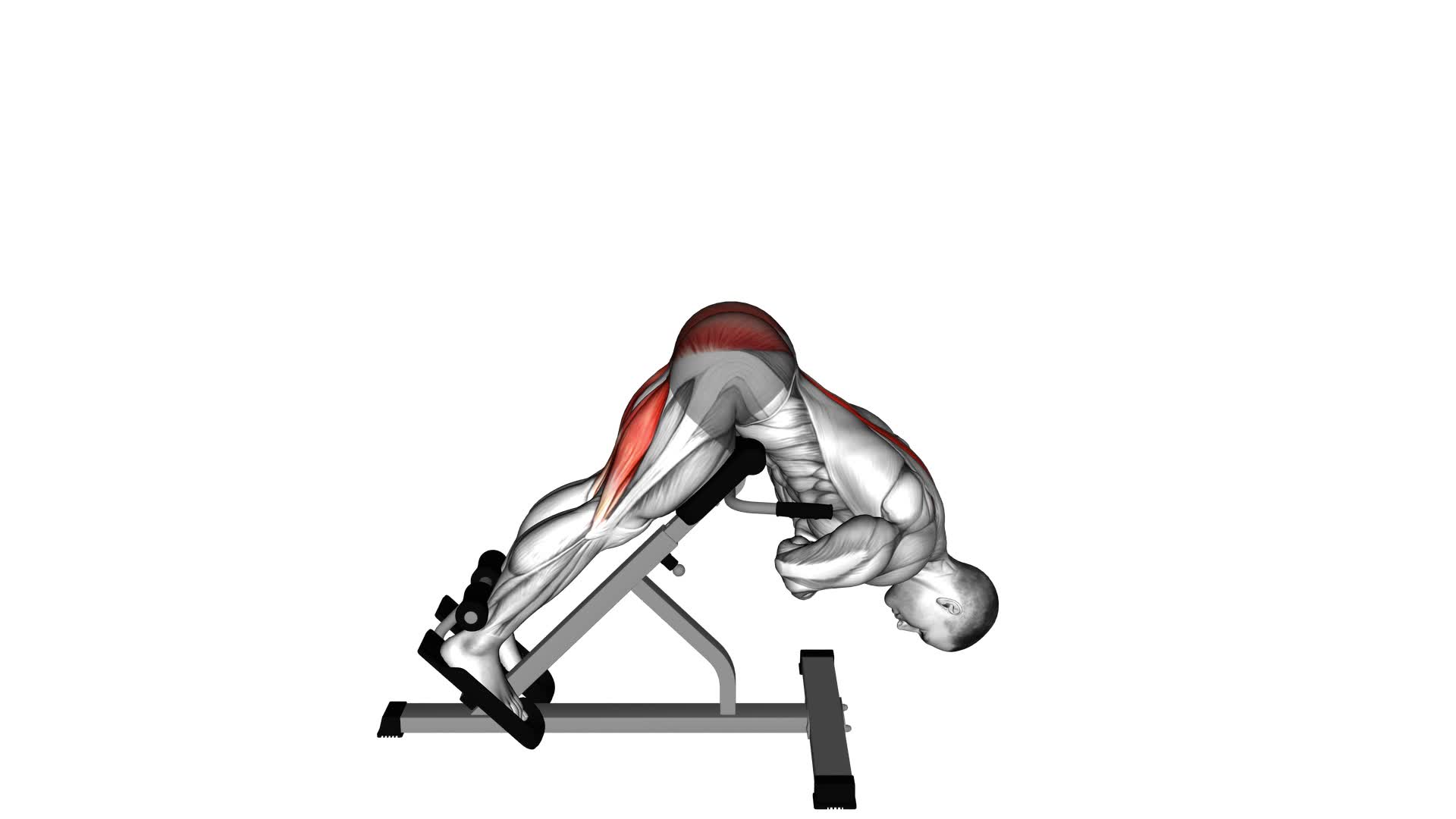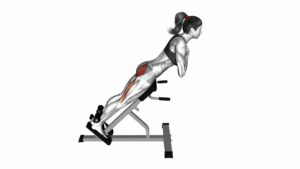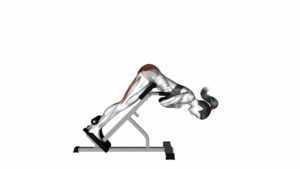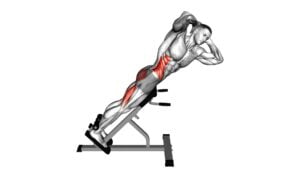45 Degree Hyperextension (Arms in Front of Chest) (Male) – Video Exercise Guide & Tips

Looking to strengthen your core and back muscles? Check out this video exercise guide on the 45 degree hyperextension with arms in front of your chest.
Watch This Exercise Video
This exercise targets your lower back, glutes, and hamstrings, helping to improve posture and overall stability. With the proper form and technique, you can maximize the benefits of this exercise.
Watch the video and follow the tips to ensure safe and effective workouts.
Let's get started!
Key Takeaways
- The 45 Degree Hyperextension exercise increases core strength.
- It improves posture and enhances balance and body control.
- The exercise can alleviate back pain.
- It sculpts and tones the glutes and hamstrings.
Benefits of the 45 Degree Hyperextension
Experience five key benefits from incorporating the 45 degree hyperextension into your fitness routine.
This exercise is highly effective in increasing core strength and improving posture. By engaging your core muscles, including the abdominals, obliques, and lower back, the 45 degree hyperextension helps to strengthen and stabilize your midsection.
This can lead to improved balance and overall body control during other exercises and daily activities. Additionally, the exercise targets the muscles in your lower back, helping to alleviate back pain and reduce the risk of injury.
Another benefit of the 45 degree hyperextension is that it can help to improve your posture by strengthening the muscles that support your spine. By regularly incorporating this exercise into your routine, you can enhance your ability to maintain proper alignment and prevent slouching.
Lastly, the 45 degree hyperextension can also help to sculpt and tone your glutes and hamstrings, making it a great addition to any lower body workout.
Now that you understand the benefits, let's move on to the equipment needed for the exercise.
Equipment Needed for the Exercise
To continue incorporating the 45 degree hyperextension into your fitness routine, you'll need some equipment. Here are the required equipment and common mistakes to avoid:
- Required equipment:
- Hyperextension bench: This specialized equipment is designed to provide support and stability during the exercise. Look for a bench that allows you to adjust the angle to 45 degrees.
- Weight plate or dumbbell: Adding resistance to the exercise can help increase the intensity and challenge your muscles. Start with a weight that's challenging but manageable for your fitness level.
- Exercise mat: Placing a mat underneath the bench can provide cushioning and comfort during the exercise.
- Common mistakes to avoid:
- Using too much weight: It's important to start with a weight that allows you to maintain proper form throughout the exercise. Using too much weight can compromise your technique and increase the risk of injury.
- Overextending your back: Avoid hyperextending your back at the top of the movement. Instead, focus on maintaining a neutral spine position to engage your core and protect your lower back.
- Relying on momentum: Perform the exercise in a controlled manner, using your muscles to lift and lower your body. Avoid using momentum to swing or jerk your body during the movement.
Proper Form and Technique
To ensure proper form and technique during the 45-degree hyperextension exercise, you should consistently and carefully engage your core muscles. This is crucial for maintaining stability and preventing injury.
A common mistake is failing to activate the core, which can lead to strain on the lower back. Remember to keep your abdominal muscles tight throughout the entire movement.
Another important aspect of proper form is maintaining a neutral spine. Avoid arching or rounding your back, as this can put excessive stress on the spine. Instead, focus on keeping your back straight and aligned with your hips.
Additionally, it's important to control the movement and avoid using momentum. Lower yourself slowly and with control, and then lift back up using the strength of your glutes and hamstrings.
Variations and Progressions
Once you have mastered the proper form and technique of the 45-degree hyperextension exercise, you can explore various variations and progressions to challenge your muscles even further. Here are some advanced techniques and common mistakes to be aware of:
- Weighted Hyperextensions: Hold a weight plate or dumbbell against your chest while performing the exercise to increase resistance and intensity.
- Single-Leg Hyperextensions: Elevate one leg off the ground and perform the exercise using only the other leg. This variation adds instability and engages the core muscles more effectively.
- Reverse Hyperextensions: Instead of lifting your upper body, lift your legs and lower body off the ground while keeping your upper body stationary. This targets the glutes and hamstrings.
Remember, when exploring these variations and progressions, it's important to maintain proper form and technique to prevent injuries. Some common mistakes to avoid include:
- Using momentum: Avoid swinging your body or using momentum to lift yourself up. Focus on using the muscles in your lower back and glutes to perform the movement.
- Overarching the lower back: Keep your lower back in a neutral position throughout the exercise to avoid excessive strain on the spine.
- Not engaging the core: Remember to engage your core muscles to stabilize your body throughout the exercise.
By incorporating these advanced techniques and avoiding common mistakes, you can continue to challenge your muscles and make progress in your degree hyperextension training.
Now, let's move on to the next section about safety precautions and tips.
Safety Precautions and Tips
As you progress with variations and progressions in degree hyperextension exercises, it's important to prioritize safety precautions and follow these tips to prevent injuries. To ensure your safety, it's essential to maintain proper form throughout the exercise.
One common mistake is arching your back excessively, which can strain your lower back. Instead, engage your core muscles and keep your back straight throughout the movement. Another common mistake is using too much weight, which can put unnecessary strain on your joints. Start with lighter weights and gradually increase the load as your strength improves.
Modifications and alternatives can also be helpful in preventing injuries. If you're new to degree hyperextension exercises, consider starting with a modified version using a stability ball. This can provide additional support and reduce the risk of injury.
Additionally, if you experience any discomfort or pain during the exercise, it's important to listen to your body and consult with a fitness professional or healthcare provider. They can provide guidance on modifications that suit your individual needs and abilities.
Frequently Asked Questions
How Many Sets and Reps Should I Do for the 45 Degree Hyperextension Exercise?
To progress in difficulty for the 45 degree hyperextension exercise, you can increase the number of sets and reps gradually. Start with 2-3 sets of 10-12 reps and then add more sets or reps as you feel stronger and more comfortable.
Remember to maintain proper form throughout the exercise by keeping your core engaged and avoiding any excessive arching in your lower back. This will help prevent injury and maximize the effectiveness of the exercise.
Can I Perform the 45 Degree Hyperextension Exercise if I Have Lower Back Pain?
If you're experiencing lower back pain, it's important to avoid exercises that could worsen your condition. Instead of performing the 45-degree hyperextension exercise, consider alternative exercises that are gentler on your lower back, such as bird dogs or glute bridges.
Additionally, incorporating stretching and mobility exercises specific to lower back pain relief can help alleviate discomfort.
It's always a good idea to consult with a healthcare professional before starting any new exercise routine, especially if you have existing pain or injuries.
Is It Necessary to Warm up Before Doing the 45 Degree Hyperextension Exercise?
Before performing any exercise, it's always beneficial to warm up your body. Warming up helps increase blood flow to the muscles, loosens up the joints, and prepares your body for the upcoming workout.
Although warming up isn't absolutely necessary for the 45 degree hyperextension exercise, it's highly recommended to prevent any potential injuries or strains.
If you prefer not to warm up, consider alternative exercises that target the same muscle groups and provide similar benefits.
Can I Do the 45 Degree Hyperextension Exercise With a Weight Plate or Dumbbell?
Yes, you can do the 45 degree hyperextension exercise with a weight plate or dumbbell. Using a weight plate adds resistance, which can help to strengthen your lower back and glutes more effectively.
It also increases the intensity of the exercise, allowing for greater gains in strength and muscle development.
However, it's important to start with a weight that's manageable and gradually increase it as you become more comfortable and stronger.
How Long Should I Rest Between Sets When Performing the 45 Degree Hyperextension Exercise?
When performing the 45 degree hyperextension exercise, it's important to consider the rest duration between sets.
The recommended rest time is typically around 1-2 minutes. However, this can vary depending on your fitness level and personal preference. It's always a good idea to listen to your body and adjust the rest time accordingly.
Additionally, you can explore variations and modifications of the exercise to challenge yourself and target different muscle groups.
Conclusion
In conclusion, the 45 degree hyperextension exercise is a beneficial movement for strengthening the muscles in the lower back. By utilizing proper form and technique, individuals can effectively target this area and improve their overall core stability.
It's important to start with the appropriate equipment and progress gradually to avoid any potential injuries. Remember to prioritize safety and consult with a fitness professional if needed.
Keep practicing this exercise to enhance your strength and endurance in the lower back muscles.

Author
Years ago, the spark of my life’s passion ignited in my mind the moment I stepped into the local gym for the first time. The inaugural bead of perspiration, the initial endeavor, the very first surge of endorphins, and a sense of pride that washed over me post-workout marked the beginning of my deep-seated interest in strength sports, fitness, and sports nutrition. This very curiosity blossomed rapidly into a profound fascination, propelling me to earn a Master’s degree in Physical Education from the Academy of Physical Education in Krakow, followed by a Sports Manager diploma from the Jagiellonian University. My journey of growth led me to gain more specialized qualifications, such as being a certified personal trainer with a focus on sports dietetics, a lifeguard, and an instructor for wellness and corrective gymnastics. Theoretical knowledge paired seamlessly with practical experience, reinforcing my belief that the transformation of individuals under my guidance was also a reflection of my personal growth. This belief holds true even today. Each day, I strive to push the boundaries and explore new realms. These realms gently elevate me to greater heights. The unique combination of passion for my field and the continuous quest for growth fuels my drive to break new ground.



